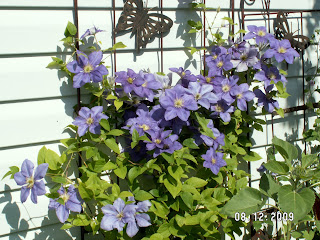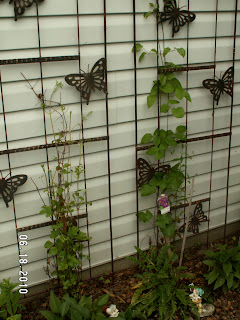What a sweet little slice of heaven to go out on the deck on a sunny morning with my first cup of coffee and listen to the busy birds singing happily in the trees nearby. They have already been up for hours by the time I join them! "Lazy bones!" they sing...
Sunday morning was such a warm, sunny, inviting morning. First I noticed the tree swallows with their irridecent royal blue wings and backs and their natty white chests perched on top of any available place with an aerial view. The tree swallows especially love sitting on the very tip top of the tree snags, the dead trees planted, one in the front yard and one in the back. They love to have an open view of their environment.
You're probably wondering... who would
plant a
dead tree deliberately? Most people cut down dead trees and in town when you have a small yard, I can see the need to do that. What most people don't realize is that a so called 'dead' tree is actually teaming with life! There is a huge amount of activity going on in a tree that has died. Insects invade it and make their homes there. Then the insect eating birds visit there regularly to make a meal of the insects. The lichens and moss also love to grow there, so it may look dead to you, but after a tree dies it actually sustains a great deal of new life!
I love when the tree swallows first show up in the spring. Then we know that spring has definitely arrived! It usually happens in early May out here, that we look out the bay window at breakfast and low and behold see that the swallows have reclaimed their birdhouse! This year, though, they came about 10 days early! We thought we were in for an early spring! Little did we all know that the "early spring" was going to change back into "late winter" 2 or 3 times before Mother Nature relented and finally gave up on throwing frost at us every night, somewhere around the 1st of June!
The swallows make their presence known as they swoop around the yard doing aerial acrobatics munching on the mosquitos and any other flying insect they might encounter. I sometimes wish I had twice as many swallows and could entice them to stay all summer, but once they have weaned their little ones, they all disappear till the next spring...
Downey woodpecker and sparrow
Then you will notice the little downey woodpecker sitting on the 'dead' tree snag hammering away for its breakfast. The little Downeys are the smallest woodpeckers and they stay here all winter. They love the suet blocks that we hang out in winter and also the oiled sunflower seeds we put in the feeders. They get somewhat possessive of the feeders and won't let any other birds come to feed while they are there if they can help it.
Then a little flash of yellow catches your eye! The little American goldfinches flit around the yard from tree to tree, rarely staying in one place for very long so they are tricky to try and photograph. These hyperactive little birds are mainly seed eaters and love to eat the little black nyger seeds in the bird feeder. Apparently goldfinches also like to eat dandelion seeds, so that is why they have their young later in the season than many other birds, to feed their young the plant seeds and most plants produce an abundance in the late summer.
The goldfinches have definitely come to the right place if they like dandelions! LOL!
There were 2 pairs of waxwings flying about by the pond following each other around. I couldn't tell if they were cedar waxwings or bohemians. They are very close in appearance. The cedars are a little lighter colored, and so I think these were bohemians, but according to my bird book, bohemians usually come in the winter and cedars in the summer....
And do they ever! They show up in huge flocks of 60, 70, 80 birds and more on a cold winter's day! You suddenly notice movement outside the window and there will be dozens and dozens of them sitting in the trees eating the chokecherries, the mountain ash berries, any saskatoons or other dried berries left over from the fall. They make a high pitched 'whirring' sound and as you watch them they will suddenly all move to a new location or disappear altogether sometimes showing up again days later to finish off what they missed the last time.
The sparrows are greatly unappreciated birds, but they are a species that stay here all year round. I had no idea that there were so many different kinds of sparrows, over 40 different ones I believe. The ones I saw on Sunday were a dark grey/ brown with black on their wings and a black stripe on their heads.
Many people don't like sparrows because they say they can be quite aggressive towards the song birds and will drive them out of their nests in order to steal the location. Many people won't let sparrows nest in their birdhouses, but I think that all things in nature have their purpose and I also believe that Man needs to be careful not to upset the delicate balance by interfering too much with the whole scheme of things.

We have 20 birdhouses here on our acreage and I have not seen the sparrows taking over more than their share of the houses. On the contrary, the swallows seem to be more aggressive. One day while looking out the kitchen window at breakfast, we saw a fight going on between a swallow and a sparrow. The swallow had chosen that particular birdhouse 2 days before and a sparrow came that morning to check it out. The swallow flew back to it's chosen home in a fury and a midair wrestling match ensued! With a flurry of wings they both wrestled to the ground and the sparrow quickly flew away. Satisfied, the tree swallow flew off to feed some more, but minutes later this whole scenario repeated itself with another midair struggle between the same pair until the swallow finally seemed to triumph and the little sparrow quickly flew off and did not return again.
The tiny hummingbirds are back and they have already used up all the sugar water in the hummingbird feeder. I'll have to replenish it tomorrow. It's easy enough to do. Just boil 4 cups of water and then mix in 1 cup of sugar. I add a drop of red food coloring just so that I can see the volume of water left in the feeder. Hummingbirds love the color of red apparently, but they are attracted to the feeder by the smell of the sugar more than the red color.

Do you have any idea how hard it is to photograph a hummingbird? They move so fast and are quite elusive. Here is a photo of a ruby throated humming bird I managed to get last summer...
I had a magical hummingbird encounter last summer while working in my flower bed. The maltese cross were blooming their red clusters of flowers and the hummingbirds were there every day. This day I heard the 'thrum' sound of the wings and I knew one was nearby. I stood up from the flower bed slowly and the tiny bird came and hovered about 2 feet in front of me. I stood stock still and enjoyed the moment as we stared at each other. It was over too soon as the hummingbird flew off, continuing its busy day! A hummingbird is the only bird that can 'hover' and the only one that can fly backwards. This tiny bird can fly up to 85 km per hour! (More late on attracting hummingbirds.)
The little house wrens are making their presence known by the cheery tune that they sing, starting just before dawn at around 4am and continuing all day until dark. I 'm quite fond of them because they eat a lot of the pesky insects that try and feed on my flowers. They eat the caterpillars right off the monkshood and delphiniums so these little helpers are always more than welcome in my garden!
Let's not forget my favourite little bird, the perennial little chickadee! I love these polite little clowns!
Today this particular one is in my flower bed doing acrobatics, hanging upside down on the tomato cage which surrounds the dahlia. :)
Chickadees reside here all winter and feed at our feeder every day. They are not fussy about what you feed them, unlike the magpies and crows who will come to the feeder and throw massive amounts of seeds out in search of the perfect one!
The little chickadees sit on the tree branches near the feeder and politely take turns flying to the feeder to pick up a seed, then fly back to the tree to eat it, while the next chickadee takes its turn to fly to the feeder and back to the tree. Some birds will sit at the feeder hogging it and not only eat nonstop, but not let anyone else eat while they are there.
I have never seen chickadees fight either. They seem to get along well with each other and with other species of birds as well. The chickadees often eat the seeds on the ground that the other birds have thrown there so I'm glad it doesn't go to waste. I'm ashamed to say that I have no photos of these little fellows. Guess I'd better rectify that!







































.JPG)







